AMD’s 5 GHz Turbo CPU in Retail: The FX-9590 and ASRock 990FX Extreme9 Review
by Ian Cutress on August 9, 2014 8:00 AM ESTCPU Benchmarks: Comparing Motherboards
Readers of our motherboard review section will have noted the trend in modern motherboards to implement a form of MultiCore Enhancement / Acceleration / Turbo (read our report here) on their motherboards. This does several things – better benchmark results at stock settings (not entirely needed if overclocking is an end-user goal), at the expense of heat and temperature, but also gives in essence an automatic overclock which may be against what the user wants. Our testing methodology is ‘out-of-the-box’, with the latest public BIOS installed and XMP enabled, and thus subject to the whims of this feature. It is ultimately up to the motherboard manufacturer to take this risk – and manufacturers taking risks in the setup is something they do on every product (think C-state settings, USB priority, DPC Latency / monitoring priority, memory subtimings at JEDEC). Processor speed change is part of that risk which is clearly visible, and ultimately if no overclocking is planned, some motherboards will affect how fast that shiny new processor goes and can be an important factor in the purchase.
Point Calculations – 3D Movement Algorithm Test: link
3DPM is a self-penned benchmark, taking basic 3D movement algorithms used in Brownian Motion simulations and testing them for speed. High floating point performance, MHz and IPC wins in the single thread version, whereas the multithread version has to handle the threads and loves more cores.
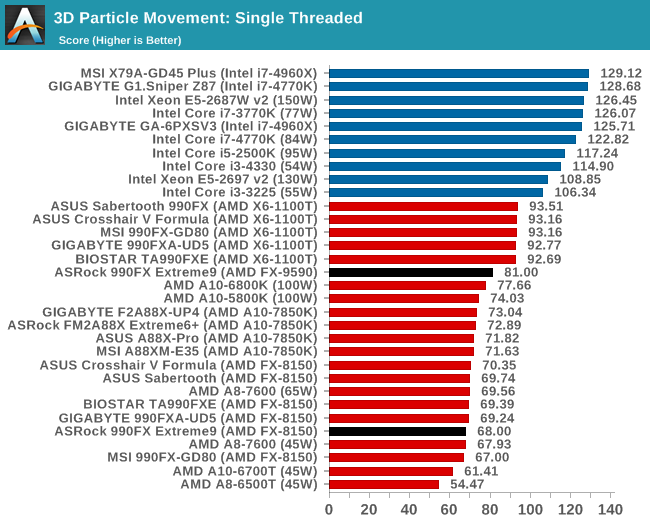

Compression – WinRAR 5.0.1: link
Our WinRAR test from 2013 is updated to the latest version of WinRAR at the start of 2014. We compress a set of 2867 files across 320 folders totaling 1.52 GB in size – 95% of these files are small typical website files, and the rest (90% of the size) are small 30 second 720p videos.
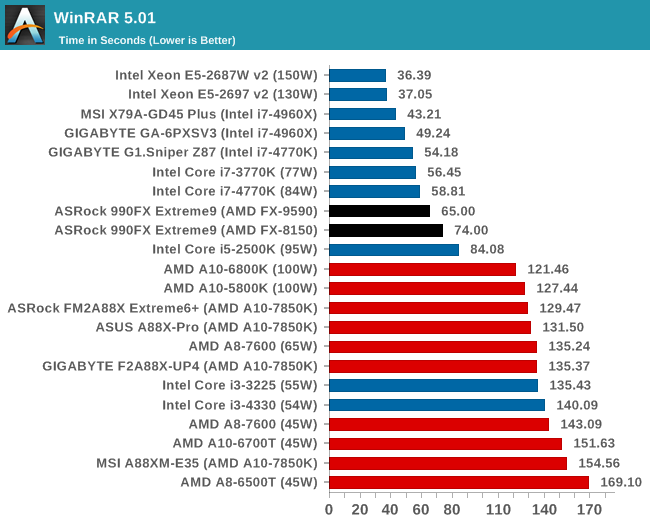
Image Manipulation – FastStone Image Viewer 4.9: link
FastStone is the program I use to perform quick or bulk actions on images, such as resizing, adjusting for color and cropping. In our test we take a series of 170 images in various sizes and formats and convert them all into 640x480 .gif files, maintaining the aspect ratio. FastStone does not use multithreading for this test, and results are given in seconds.
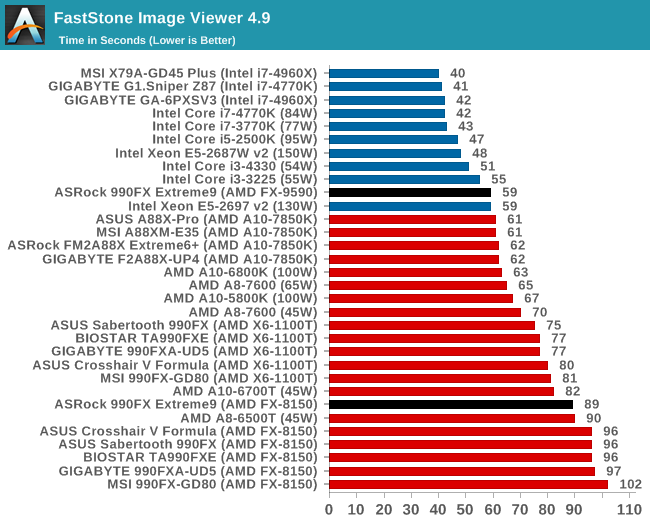
The FX-8150 result for the Extreme9 compared to other motherboards shows one of two things - the latest Windows SP1 with core parking updates has an effect, or the BIOS is more efficient at handling turbo modes than our older reviews.
Video Conversion – Handbrake v0.9.9: link
For HandBrake, we take two videos (a 2h20 640x266 DVD rip and a 10min double UHD 3840x4320 animation short) and convert them to x264 format in an MP4 container. Results are given in terms of the frames per second processed, and HandBrake uses as many threads as possible.
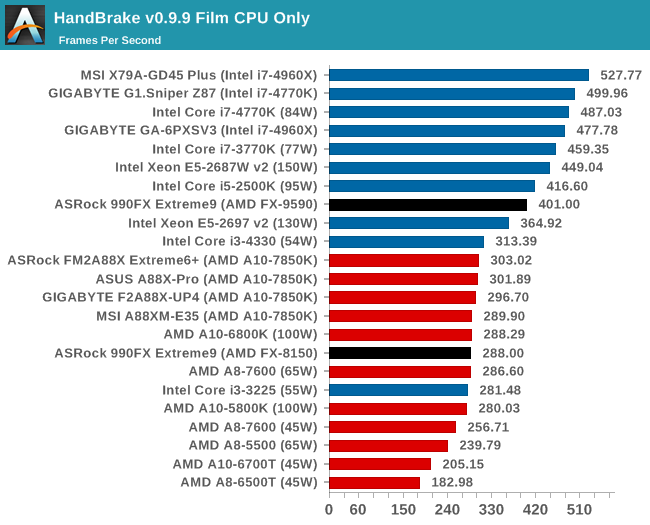

Rendering – PovRay 3.7: link
The Persistence of Vision RayTracer, or PovRay, is a freeware package for as the name suggests, ray tracing. It is a pure renderer, rather than modeling software, but the latest beta version contains a handy benchmark for stressing all processing threads on a platform. We have been using this test in motherboard reviews to test memory stability at various CPU speeds to good effect – if it passes the test, the IMC in the CPU is stable for a given CPU speed. As a CPU test, it runs for approximately 2-3 minutes on high end platforms.
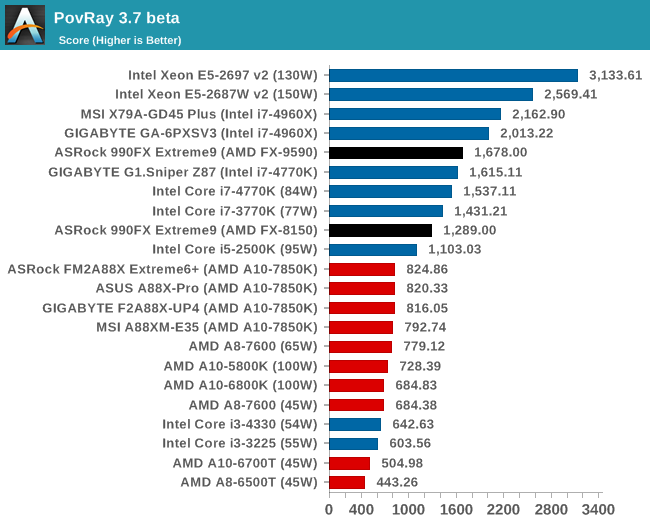
Synthetic – 7-Zip 9.2: link
As an open source compression tool, 7-Zip is a popular tool for making sets of files easier to handle and transfer. The software offers up its own benchmark, to which we report the result.
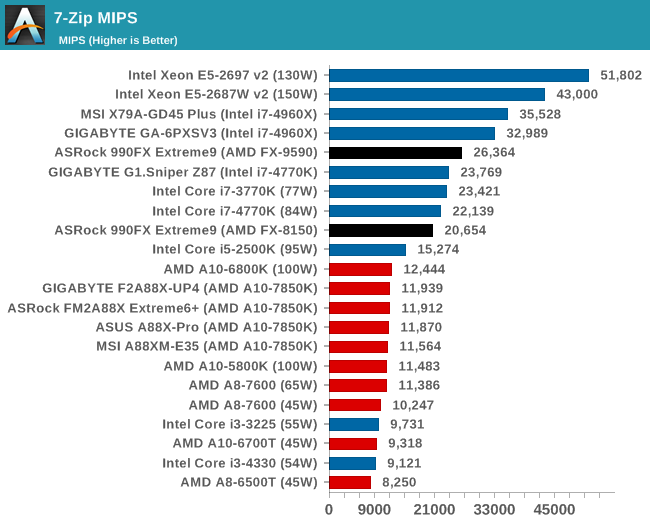










146 Comments
View All Comments
wurizen - Saturday, August 9, 2014 - link
the fx series does need to go down in watts, which only comes in a die shrink from what i know. but the thing it has going for it are 8 cores, which intel doesn't even have in their consumer or enthusiast cpu's. u have to go xeon to find an intel 8 core cpu. my theory that amd is not updating the fx series or their chipsets is probably due to the backlash of the of fx series. i forgot when the the fx-8150 came out but it was negative. i don't think amd wants to have another repeat of that so amd is putting their cards back in the deck. they're softly announcing this and that about apu's... and hoping the marketing of apu will be enough to garner positive feedback. bring the image back. that is all it is, i think. what the hell is an apu, anyway? oh, it's the future. this is what amd wants ppl to know. but, we know that apu is not the future. it's just a stop gap for amd. it's just a fancy acronym.i don't think the low performance of amd fx cpu compared to an intel part is also solely amd's fault. i think software developers/coding can also be attributed to it. i mean, if you have this and that code built for intel chips since they're inside (i hate to say it) most of the pc's in the world, then of course, intel will have a lead from the get go. for example, windows 8 is suppose to be better for amd fx cpu's than windows 7. now dig deeper into how programs are run and make it so that an fx chip will shine as much as an intel chip, then we probably have a very well optimized program, which in the real world is probably a unicorn program. so, this unicorn program puts both amd and intel chips thru its paces, equally and optimally and fully. and i think that unless an intel chip has a specific function that makes it run faster (i forgot what it is), then an amd fx 8-core chip with its more logical, fully functional, real cores of 8 will probably be better than intels 4 cores with hyperhtreading. intel has patents for those specific, specialize tasks though and this is why intel is hard to beat and why amd loses to them.
this is why amd is waiting b/c 1)amd knows intel's roadmap and 2)they have apu's and consoles as stop gap 3) they'll return to the desktop performance cpu when the tide, the program/software/patents or whatever it is has leveled out so that amd can put out a competitive product that is truly innovative. and not just tick and tocks 4) the cpu fabs are probably too expensive right now for amd to jump in and do a die shrink (not sure tho; maybe intel has a hand in that too? idk)--like why is intel the only cpu company doing die shrinks every year and half? sounds weird to me. and it's closest competitor is just sitting back. weird right? anyway, im out of theories, i think.
oh, you'd think amd would just put 8 core kaveris without an igpu, right? but, no. i think amd is still not sure the performance gain with that will be enough to wipe out the negativity of the fx-8150 debacle. so, amd is just not doing it.
what do you guys think of my theories?
Death666Angel - Sunday, August 10, 2014 - link
"but the thing it has going for it are 8 cores, which intel doesn't even have in their consumer or enthusiast cpu's."I stopped reading right there. If you think 8 cores in a 4 module FX CPU are comparable to 4 cores in Intel mainstream CPUs or 8 cores in Intel enthusiast CPUs, you should go back and read up on the architecture differences. The fact that an Intel 8 thread CPU (core i7 with 4 cores and HT) usually beats any FX CPU with 4 modules should be warning enough that you shouldn't draw any conclusions based on that.
wurizen - Sunday, August 10, 2014 - link
Ive read up on bulldozer architecture. 4 modules with 2 logical and physical cores = 8 cores. Intels hyperthreading arent physical cores but software driven. so an OS sees an i7 with 8 cores even tho 4 of those cores are virtual. AMD has 8 physical/logical cores. Each module or 2 cores do have to share FpU, l2 cache (i think) and another thing. So, the cores are hampered by this but it doesnt take away the fact that there are 8 cores there. And i know its slow even though it has more cores than intel. But by refining it and better software optimization, i am wishing AMD to at least compete with intel enthusiast x99 chipset in the future with half the price. Why? Bc i cant afford intel. Simple as that.mapesdhs - Tuesday, August 12, 2014 - link
Sorry it's not an 8-core at all, not when it has to share resources split int vs. fp. Hence whythis very article shows again and again the older 4770K beating the 959 on threaded loads,
with 60% less power consumption. Convincing yourself that AMD's "8 cores" marketing has
any kind of sensible basis is as bad as believing MHz is an equally useful metric, or MIPS.
Intel's real, old, 6-core, the 3930K, utterly demolishes the 9590, for less power, etc. If you're
on a budget, buy a used 3930K, it'll leave AMD's chips in the dust, and there are plenty of
low cost X79 boards these days, especially on the used market (Gigabyte UD3 only cost me
55 UKP).
Ian.
Budburnicus - Wednesday, January 14, 2015 - link
Noob, 2x ALU per unit DOES NOT equal 2 FULL CPU cores! The ONLY "edge" AMD has gained by this, frankly, AWFUL architecture, is in marketing, because they can somehow LEGALLY call each unit 2 CPU cores - when they do not function as such at all! In fact, HyperThreading provides better real world performance that doubling APU's when the architecture involved has much higher IPC as well as a DEDICATED minimum of 168 GB/s to L3 cache per core, at stock speeds!AMD calling a 4 unit CPU an 8 core machine is essentially the same as intel calling a 4 core i7 an 8 core CPU! HyperThreading is NOT software! read more about CPUs bro.
Budburnicus - Wednesday, January 14, 2015 - link
*than doubling ALUs*Budburnicus - Wednesday, January 14, 2015 - link
EXACTLY! +1Laststop311 - Monday, August 11, 2014 - link
you said intel has no non xeon 8 core cpu's. But haswell-e will have 8 core/16 thread. I currently run an i7-980x gulftown x58 system and will be replacing it with 8 core haswell-e. video production speed should sky rocket.mapesdhs - Tuesday, August 12, 2014 - link
That depends on what you're doing, which app, where the bottlenecks reside, etc.If you've already oc'd your 980X then you're starting from a pretty good baseline,
so don't expect HW-E to be that much better (NB: I have a 990X, a couple of 3930Ks,
4820K, seveal 2700Ks, etc.)
What really will help for you is the newer I/O provision, ie. SATA3, PCI Express, M.2, etc.
The non-Intel SATA3 controllers on X58 boards were pretty awful, especially Marvell.
And of course you can at least double your max RAM, which might be holding you back
somewhat if you're a heavy AE user.
Ian.
Arbie - Sunday, August 10, 2014 - link
I think 'ur' Shift key is broken.